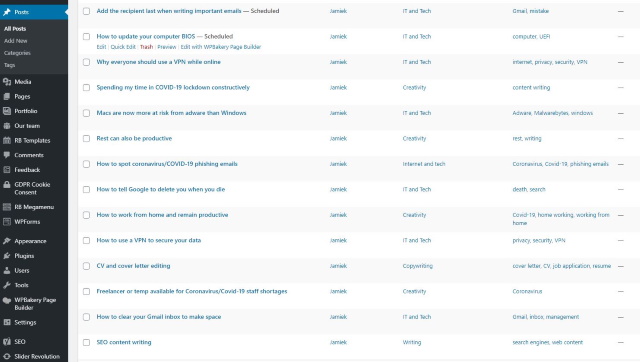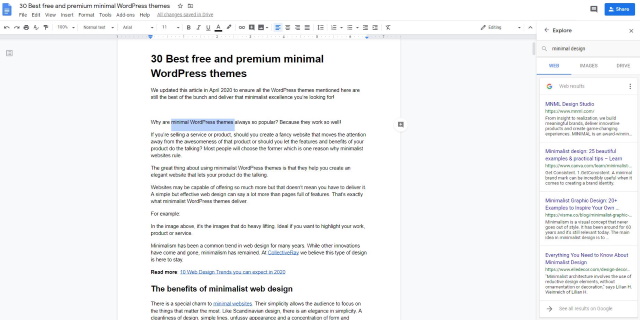How to refresh your web content

Web content maintenance is one of the factors Google looks at as part of its Quality Rating Guidelines. If your website has been running a while, revisiting some of your content could qualify as maintenance as well as attracting new readers and new links.
So how do you go about refreshing your web content?
Like most undertakings, first it begins with a plan.
Planning a web content refresh
While a content refresh should include a formal plan, it doesn’t have to be extensive or overly complicated. It should include a few keys points though.
- How the business or intent of the site has changed.
- How the audience, world view and external factors have changed.
- What content is worth refreshing and what should be left alone.
- What pages perform particularly well.
1. How the business or intent of the site has changed
Is the website or the business the same as it was when you first began? Has the target audience changed? The depth, breadth or type of product or service changed? Does your existing content and blog posts still reflect your current values?
All these questions need to be answered to get the most out of a content refresh.
2. How the audience, world view and external factors have changed
Does your content still reflect commonly held views? Are any of your blog posts now regarded as having outdated or old fashioned viewpoints? Are any of the terms used now regarded as offensive by the liberal masses?
If you created audience personas when you originally set up your website, now would be a good time to revisit them. Are they still relevant? Are the characteristics you attributed to them still realistic? Have you widened your appeal and need more personas?
3. What content is worth refreshing and what should be left alone
Not all website content needs to be refreshed. All of your cornerstone content should be current and regularly revisited. Cornerstone content is your most informative, most important, most SEO-oriented content.
This will differ depending on the intent of the site but could include service pages and explanations, long form blog posts and any content you purposely created to rank for particular terms.
4. What pages perform particularly well
You may have some pages or blog posts that are not intended as cornerstone content but perform well anyway. It makes sense to keep these pages up to date so they can continue performing.

Performing the content refresh
While the main focus of any content refresh should be on your cornerstone content, you should check every single page and post of your website. Check language, spelling, grammar, images and links. Especially links. Nothing says out of date than a 404 when you click a link.
Use SEO best practices to rewrite the content to appeal to modern audiences and search engines. Make sure sentence and paragraph composition are suitable, configure pages to attract the rich snippet for each term and make sure all content has been reviewed and refreshed where necessary.
Measured content refresh
When rewriting pages or blog posts, you have to be careful to improve the content in all the right ways without losing that element that made them popular in the first place.
Care must be given to retain the original character, intent, keyword terms and feel of each popular page while also updating it with new links, new information, new content and new sources.
It’s a delicate balance but one that can be done successfully with practice.
Double check links and references
Even though you have already checked the links of every page, do it again. While you’re there, check any references you may have cited in any work and update or replace as necessary. Some references won’t change while others will change year on year.
Statistical findings should always use the latest references and be updated to reflect the any new ideas. News reports and reference documentation should be updated to recent or higher profile resources if available.
Check and test, check and test
Once you have updated your web content, it’s time to check and test. Have others in your organisation read and offer opinion. If you have made friends with commenters, ask their opinion too. Check all new content using your SEO tools to make sure they haven’t lost their magic or intent.
Once that first round of checks has been complete, run it again. Make any suggested changes from the first round and then check and test again. It is time consuming but you are much better righting any wrongs in the privacy of your office than in the publicity of the internet!
Add a note to each refreshed blog post
There are several ways you can tell the audience blog content has been refreshed. You can do it in the title by adding ‘refreshed for 2020’ at the end. You could re-date it with the republished date or you could add an editor’s note at the top telling the reader the piece has been updated for current times.
How you go about it is entirely up to you and you may find a mixture of the above works best.
Personally, I like a mix of adding the current year in the title and editor’s note. The editor’s note is a short paragraph at the very top of a blog post telling the reader it has been updated to be relevant in the now. It is a good signal to the search engines that you’re maintaining your website and a good sign to the reader that you’re maintaining your content to remain relevant.



